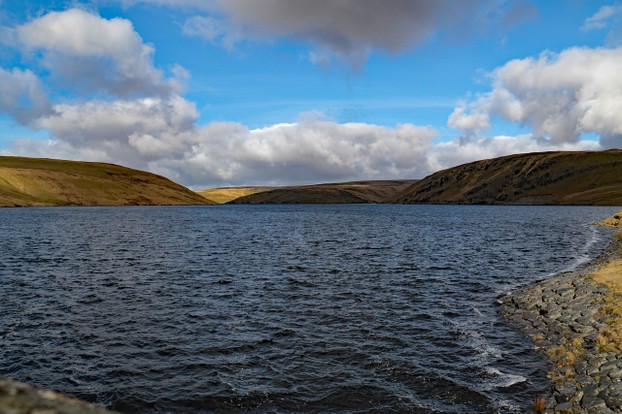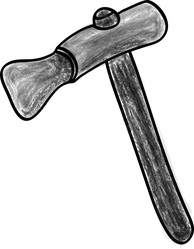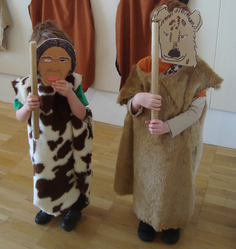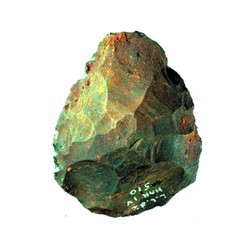Professor Brian Sykes, distinguished geneticist, was on field work in rural Wales when someone approached him to ask his views on a local legend. There had been two bachelor brothers who were known locally as the Neanderthals. The brothers were now deceased, but their memory remained. What did the learned professor think about this, the man inquired.?The professor, ever alert for a discovery, set out to investigate.

The Mystery of the Tregaron Neanderthals
by frankbeswick
In East Wales a legend that some people with Neanderthal traits persisted was held by many people
The Tale of the Welsh Neanderthals
Doing field work in damp East Wales in a cold October in the late 1990s was a chilly task,so the team of geneticists were looking forward to having supper in a pub [inn,tavern] where they could dine in the warmth of a good fire and have a few pints of beer. But Professor Sykes could not resist combining dining with field work, so he spoke to people standing at the bar about his research on the population genetics of Britain to elicit willing subjects for his inquiries.
Why did the Oxford professor choose the Tregaron region, which is a mountainous area of East Wales centred on the mountain plateau of Plynlimmon and part of the wider, ill-defined district of Elenydd, the Green Desert of Wales, the loneliest, least populated part of the Principality of Wales, a land of small towns and widely spread sheep farms and dark night skies unsullied by artificial illumination? The reason was that Tregaron and Elenydd in general has a relict population, one that has been stable in the area for many thousands of years, probably going back to the first post-ice age settlers of Britain. Moreover, in the days prior to railway travel local physical types could be easily recognised, for families tended to stay in their native regions, and there had been a distinct, recognisable Tregaron type. Not that everyone looked that way, but many did.
While buying some beer at the bar Professor Sykes was approached by a man who told him of the James brothers. These now deceased bachelor farmers who dwelt in an old farm house above the ruined abbey of Strata Florida [Flowery Valley] were known as the Neanderthals because of their physical appearance. Belonging to a family long-rooted in the region, they were thought to have been "throw backs" to an earlier physical type. A local legend developed that these two were the last surviving Neanderthals. No one doubted that they were human, but there was a belief that in them Neanderthal traits survived to a great degree.
The brothers accepted all this in good grace and seemed to agree that they were Neanderthals.They co-operated with the local school in having annual visits from school children studying human evolution, who were taken to see the Neanderthals. The lonely bachelors happily treated the children to cake and fizzy drinks. Even a local museum asked the last surviving James brother to donate his skull after death, but that offer was withdrawn later. Sadly the James were forced out of their family farm by a valley flooding reservoir project. Both have since died and exhumation cannot be legally justified, so scientific closure on the mystery cannot be had by experimental means. But if science cannot resolve the problem, history of science can go some way towards doing so.
Old-Fashioned Anthropology
Human anthropology has advanced much in my life-time.Years ago it was obsessed with racial types,and was dominated racist agenda that identified certain superior types and dominant races. Naturally, in the British Isles the dominant race was the English, who were identified as a tall, fair, Saxon, Germanic type,who had pushed the smaller, darker inferior Celtic peoples to the fringes. The word master race was not used, but all these beliefs were on the same spectrum. At school we were taught that the Saxons had massacred and/or expelled the Celts, leaving England inhabited by a Germanic type. That sort of thinking never appealed to me, especially as I knew myself to be partly of Irish stock. Nowadays this thinking is happily redundant, but it was damaging.
In the late nineteenth century anthropologists were obsessed with measuring skulls and linking them to racial types. In Britain they identified what they called brachicephalic and dolichocephalic [round headed and long headed] types respectively. Different skull types were linked to different racial groups. This sort of thinking was popularised by a scholar called John Beddoe, who was operating in the late nineteenth century, who identified several physical types and linked them to the groups who "invaded" Britain.
Herbert John Fleure, who lectured at Aberyswyth between 1904 and 1958 did an enormous amount of work on human anthropology. He did make progress by observing that skull measurements were averages, but he was still attached to the identification of physical groups. Fleure, however, argued that the first post-ice age inhabitants of Britain were a swarthy type who had been pushed back to rockier regions by the invading Celts, who were in their turn pushed to the fringes by the Germanic Saxons. Fleure argued that the Celts had taken the valleys, leaving the uplands to the dark people. You find traces of this erroneous theory in the novels of Rosemary Sutcliffe, particularly in Warrior Scarlet and Sword at Sunset. Tregaron is a mountainous region, so the defeated aborigines of Britain clearly had in Fleure's view retreated there.
But Fleure believed that within the inhabitants of Tregaron he had detected a trace of people who were more dolichocephalic than was the norm for the dark people. They had strong orbital ridges above the eyes and were slightly pinched in at the temples. They had strong heavy faces. Fleure, who was widely read in archaeology saw a comparison between these individuals and the skeletons discovered at Combe Capelle in France, which were the remains of an early Cromagnon group of European ancestors. But be clear, the Cromagnons were Homo Sapiens rather than Neanderthals,so Fleure never thought that he had discovered a surviving Neanderthal population in Wales. He believed that this small strain within a relict population represented survival of our early Cromagnon ancestors, or the ethnic type thereof. Was he right? Well there are physical affinities, but they were not Neanderthals, and we cannot be sure. What can be said is that maybe the genes of the Combe Capelle population survived in the Tregaron region. This is the most plausible understanding.
Elenydd
 Elenydd Kdsphotos |
The Explanation
The truth of the matter seems to be that the James brothers were victims of some muddled thinking. Clearly, coming from a family long-rooted in Tregaron they would have represented the physical type common in that locality. But they were not Neanderthals, for the Neanderthals had several physical characteristics not found in modern humans, notably in the head shape.If they were any physical type at all they were Cromagnon, as anthropologically Homo Sapiens as you and I.
So how had the claim that these men were Neanderthal come about. I suspect that rumours went round Tregaron that some of the locals were descended from cave men. When people heard the word cave men they had an image of Neanderthals, so the misconception that the descendants of Neanderthals still dwelt among them spread. Many people would be sensitive about being descended from cavemen, so it the legend of Neanderthal descent became focused on two distinct-looking men, who became known as the Neanderthals.
The strange thing is that since Professor Sykes sought in vain for Neanderthal DNA it has been discovered that the DNA of all non-African human groups is thought to contain about two per cent Neanderthal or in Asia Denisovan , another type of human similar to Neanderthals. Homo Sapiens and Neanderthals interbred with each other, but the sapiens genes dominated. It is now unclear whether the Neanderthals were a species distinct from Homo Sapiens or a subspecies of sapiens. Whatever the case,modern thinking is moving away from the view of our Neanderthal relatives as ugly, brutish and dim. They buried their dead with reverence and apparently cared for their sick and injured and old. We know this as Neanderthal remains that indicate bone healing have been found,which would not have happened if their injured were simply left to die. I am glad that their descendants still walk among us.
Further reading
www.academia.edu/23093408/The_Welsh_Neandertals
You might also like
The Stone Age for KidsResources for learning about the Stone Age for kids. Fun facts, videos to wat...
Humans, the Tool MakersHuman beings - Homo sapiens - have come a long way from our ancestors, most i...






 Women of the Gospelson 10/11/2025
Women of the Gospelson 10/11/2025
 Religious Gardenson 08/25/2025
Religious Gardenson 08/25/2025
 Doctor of the Church: John Henry Newmanon 08/03/2025
Doctor of the Church: John Henry Newmanon 08/03/2025
 Restoring the Palm Houseon 07/16/2025
Restoring the Palm Houseon 07/16/2025



Comments
None that I know of
Thank you for your comment below, in answer to my previous observation and question.
Extinct, isolate and undecipherable languages intrigue me.
Is there -- among east-ponder agencies, institutions, organizations or peoples -- any artifact or any document, associated with the British Isles or brought from somewhere else, that invokes any one of the three situations above?
That is the reason for incomplete histories. You have got to the centre of the problem
Thank you for your comment below, in answer to my previous observation and question.
It's heartening that Celtic saints are remembered even as it's disheartening that that memory is so incomplete.
Might these incomplete histories and stories be because the information source is not known at all or because it's inaccessible or undecipherable?
Very little is known about most Celtic saints. L,
Thank you!
English Wikipedia associates the place name Tregaron with "town of St. Caron." Catholic Online associates St. Caron with that place's titular saint.
But the above source communicates only the feast day March 5, without any other information.
Is there any tradition anywhere about anyone, anything connected with St. Caron?
No. There was no record. The supposed neanderthals were normal Homo Sapiens who were a just a bit different from the majority
The second paragraph to the first subheading, The tale of the Welsh Neanderthals, advises us that "Why did the Oxford professor choose the Tregaron region, which is a mountainous area of East Wales centred on the mountain plateau of Plynlimmon and part of the wider, ill-defined district of Elenydd, the Green Desert of Wales, the loneliest, least populated part of the Principality of Wales, a land of small towns and widely spread sheep farms and dark night skies unsullied by artificial illumination? The reason was that Tregaron and Elenydd in general has a relict population, one that has been stable in the area for many thousands of years, probably going back to the first post-ice age settlers of Britain."
Unitedstatesians admire British Isles-ers as world-best family historians and genealogists. Is there an oldest-known, valid genealogical account for Tregaron specifically and Elenydd generally?
When we talk about the ethnicity of the Welsh it is worth noting that in the early post-Roman period there were several small Irish settlements on the Welsh coast, so there was an Irish input into Welsh genes.
The brothers died childless,but you could be a relative. Black curly hair was always noted among the inhabitants of part of Wales. The Romans saw this and inferred that the natives were related to the Spanish. But thick, curly red hair is known among the Welsh and Irish.
You might trace back your Welsh ancestors to ascertain where they came from. My mother had ancestors from Shropshire, a part of England adjoining the border with Wales, and they were the one element in my otherwise fair and freckled, red haired family who were darker of complexion.